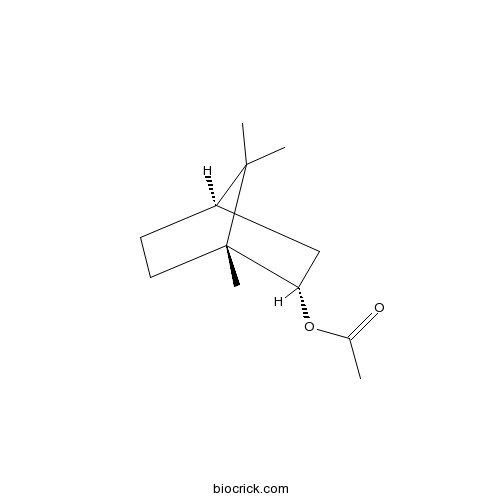Abies fargesii
Abies fargesii
1. The products in our compound library are selected from thousands of unique natural products; 2. It has the characteristics of diverse structure, diverse sources and wide coverage of activities; 3. Provide information on the activity of products from major journals, patents and research reports around the world, providing theoretical direction and research basis for further research and screening; 4. Free combination according to the type, source, target and disease of natural product; 5. The compound powder is placed in a covered tube and then discharged into a 10 x 10 cryostat; 6. Transport in ice pack or dry ice pack. Please store it at -20 °C as soon as possible after receiving the product, and use it as soon as possible after opening.
Natural products/compounds from Abies fargesii
- Cat.No. Product Name CAS Number COA
-
BCN8317
(+)-Bornyl acetate20347-65-3
Instructions

-
BCC9217
Camphene79-92-5
Instructions

[Spatial point pattern analysis of main trees and flowering Fargesia qinlingensis in Abies fargesii forests in Mt Taibai of the Qinling Mountains, China].[Pubmed: 29692090]
采用单变量和双变量O-ring函数对太白山大熊猫栖息地巴山冷杉林主要树种的空间分布格局、种间关联性及其与林下开花箭竹的空间关联性进行了多尺度分析.结果表明: 巴山冷杉林中,巴山冷杉数量最多,但种群结构衰退,白桦种群相对年轻,种群结构稳定,红桦种群也呈衰退趋势;3个主要树种在小尺度上呈聚集分布,随尺度增加,逐渐表现为随机分布.3个树种的空间关联性主要表现在小尺度范围内,随尺度增加,空间分布格局逐渐表现为不关联;巴山冷杉和白桦与开花秦岭箭竹在大、中尺度内呈现正相关,而红桦与开花秦岭箭竹在大、中尺度上表现出负相关.大熊猫栖息地内乔木和林下秦岭箭竹共同推动森林的动态演替和发展,进而影响秦岭大熊猫栖息地的环境变化.
Triterpenoids from the branch and leaf of Abies fargesii.[Pubmed: 27456555]
Eighteen triterpenoids, abifarines A-R, including fourteen previously unknown and four artifacts, together with six known ones, were isolated from the branch and leaf of Abies fargesii. Their structures were elucidated by spectroscopic data analysis. The relative configurations of abifarines A and F were further confirmed by single-crystal X-ray diffraction analysis with Mo Kα irradiation. All compounds were evaluated for their in vitro cytotoxicity against the mouse cancer B16 cell line, and human cancer HepG2 and MCF7 cell lines. (24R)-cycloartane-3β,24,25-triol and (24R)-cycloartane-3β,24,25,28-tetrol showed moderate anti-proliferative effect for B16 and HepG2 cell lines with IC50 values of 32.9, 19.5 μM and 26.4, 21.5 μM, respectively.
Diterpenoids from the branch and leaf of Abies fargesii.[Pubmed: 26969787]
Five new abietane diterpenoids, named abifadines A-E (1-5), and nine known ones (6-14), together with two known podocarpenes (15 and 16), were isolated from the branch and leaf of Abies fargesii. Their structures including the relative configurations were established on the basis of extensive spectroscopic analyses. The absolute configuration of 1 was determined through single-crystal X-ray diffraction analysis with Cu Kα irradiation. All the isolates were evaluated for their in vitro cytotoxicities. Only compounds 5 and 12 exhibited weak anti-proliferative effects against three cancer cell lines (B16, MCF7, and HepG2) with IC50 values range from 14.8 to 42.8 μM. The antimicrobial activities against Staphylococcus aureus, Escherichia coli and Monilia albicans of all compounds were also tested, but none of them showed significant activities.
February-May temperature reconstruction based on tree-ring widths of Abies fargesii from the Shennongjia area in central China.[Pubmed: 26759230]
February-May temperature strongly affects ecological processes and socio-economics in central China, yet its long-term variability has not been thoroughly assessed due to the shortness of instrumental records. In order to improve the understanding of the regularities of temperature variability in central China, in this study, we present a new tree-ring chronology from the Shengnongjia Mountains in central China which provides a valuable 245-year record of temperature variability. The reconstructed temperature correlated strongly with February-May mean temperature records of the Fangxian meteorological station from AD 1958 to AD 2011, and the derived reconstruction explained 44.5 % of the instrumental temperature variation during this period. The study shows that this region experienced three warm periods and two cool periods, i.e., the major warm periods occurred in AD 1783-1806, AD 1879-1909, and AD 1975 to the present, whereas the cool intervals occurred in AD 1807-1878 and AD 1910-1974. This reconstruction could aid in the evaluation of regional climate variability in subtropical China.
[Growth response of Abies fargesii to climate in Shennongjia Mount of Hubei Province, Southeastern China].[Pubmed: 26211049]
A well-replicated Abies fargesii tree-ring width chronology in the Shennongjia Mount was developed to investigate its radial growth response to climate variables (e.g., monthly mean tempe- rature and total precipitation) and other growing season indicators (e.g., cumulative temperature, continuous days, initial and final dates). Correlation analyses showed that the tree-ring width was positively correlated to the mean temperatures of February, April and September, and negatively correlated to the total precipitation of September, prior September and prior December. The analyses between the chronology and other growing season parameters showed that tree growth responded positively to the cumulative temperature and continuous days of the growing season. The correlation was the highest when the growing season was defined as the days above the temperature threshold of 9.0 °C. Defined this way, the growing season typically started in late-May and ended in mid-September, lasting about 120 days. Correlation analyses were also conducted between the tree-ring growth and the initial and final dates of the growing season. Results showed that correlation was the highest for initial dates defined at 9.0 °C (with the coefficient of -0.25 and p-value close to 0.05), and for final dates defined at 9.3 °C (with the coefficient of 0.33 and p-value less than 0.05). All these results indicated that the sensitive temperature threshold for photosynthesis of A. fargesii was around 9.0 °C. The year 1978 marked an abrupt shift of climate in southeast China. We compared A. fargesii growth between pre-1978 and post-1978 periods. Results showed that as temperature rose, the growing season was lengthened with both earlier initial dates and later final dates. Longer growing season increased the A. fargesii growth in the Shennongjia Mount, southeastern China.
Temporal variations of mobile carbohydrates in Abies fargesii at the upper tree limits.[Pubmed: 24954386]
Low temperatures are associated high-altitude treelines, but the functional mechanism of treeline formation remains controversial. The relative contributions of carbon limitation (source activity) and growth limitation (sink activity) require more tests across taxa and regions. We examined temporal variations of mobile carbon supply in different tissues of Abies fargesii across treeline ecotones on north- and south-facing slopes of the Qinling Mountains, China. Non-structural carbohydrate (NSC) concentrations in tissues along the altitudinal gradient on both slopes changed significantly in the early and late growing season, but not in the mid-growing season, indicating the season-dependent carbon supply status. Late in the growing season on both slopes, trees at the upper limits had the highest NSC concentrations and total soluble sugars and lowest starch concentrations compared to trees at the lower elevations. NSC concentrations tended to increase in needles and branches throughout the growing season with increasing elevation on both slopes, but declined in roots and stems. NSC concentrations across sampling dates also indicated increases in needles and branches, and decreases in roots and stem with increasing elevation. Overall altitudinal trends of NSC in A. fargesii revealed no depletion of mobile carbon reserves at upper elevation limits, suggesting limitation of sink activity dominates tree life across treeline ecotones in both north- and south-facing slopes. Carbon reserves in storage tissues (especially roots) in the late growing season might also play an important role in winter survival and early growth in spring at upper elevations on both slopes, which define the uppermost limit of A. fargesii.
Increased genetic divergence between two closely related fir species in areas of range overlap.[Pubmed: 24772279]
Because of introgressive hybridization, closely related species can be more similar to each other in areas of range overlap (parapatry or sympatry) than in areas where they are geographically isolated from each other (allopatry). Here, we report the reverse situation based on nuclear genetic divergence between two fir species, Abies chensiensis and Abies fargesii, in China, at sites where they are parapatric relative to where they are allopatric. We examined genetic divergence across 126 amplified fragment length polymorphism (AFLP) markers in a set of 172 individuals sampled from both allopatric and parapatric populations of the two species. Our analyses demonstrated that AFLP divergence was much greater between the species when comparisons were made between parapatric populations than between allopatric populations. We suggest that selection in parapatry may have largely contributed to this increased divergence.
[Species composition and point pattern analysis of standing trees in secondary Betula albosinensis forest in Xiaolongshan of west Qinling Mountains].[Pubmed: 22263460]
An investigation was conducted on the species composition and population diameter-class structure of a typical secondary Betula albo-sinensis forest in Xiaolongshan of west Qinling Mountains, and the spatial distribution pattern and interspecific correlations of the main populations were analyzed at multiple scales by the O-ring functions of single variable and double variables. In the test forest, B. albo-sinensis was obviously dominant, but from the analysis of DBH class distribution, the B. albo-sinensis seedlings were short of, and the natural regeneration was very poor. O the contrary, the regeneration of Abies fargesii and Populus davidianas was fine. B. albo-sinensis and Salix matsudana had a random distribution at almost all scales, while A. fargesii and P. davidianas were significantly clumped at small scale. B. albo-sinensis had positive correlations with A. fargesii and P. davidianas at medium scale, whereas S. matsudana had negative correlations with B. albo-sinensis, A. fargesii, and P. davidianas at small scale. No significant correlations were observed between other species. The findings suggested that the spatial distribution patterns of the tree species depended on their biological characteristics at small scale, but on the environmental heterogeneity at larger scales. In a period of future time, B. albo-sinensis would still be dominant, but from a long-term view, it was necessary to take some artificial measures to improve the regeneratio of B. albo-sinensis.
[Evaluation of forest ecosystem services value in Liaoning Province].[Pubmed: 20879539]
Based on the long-term located observation of forest ecosystem, and by using the 2006 forest resources inventory data of Liaoning Province and the forest industry standard of the People's Republic of China( LY/T 1721-2008, specification for assessment of forest ecosystem services in China), an evaluation was made on the material quantity and services value of main forest ecosystems in fourteen cities of Liaoning Province. In this province, the forest ecosystem services value supplied by water storage, soil conservation, C fixation, O2 release, nutrients accumulation, environment purification, biodiversity conservation, and forest recreation in 2006 was 2591.72 x 10(8) yuan, which was 8.54 times of the forestry production value and 28.02% in the GDP of the province. The services value of water storage, biodiversity conservation, C fixation, and O2 release occupied 79.09% of the total, being the main forest ecosystem services in the province. Economic forest and shrub had smaller per unit services value but larger area, and hence, their ecosystem services value should not be ignored. Abies fargesii forest, Phellodendron amurense forest, Juglans mandshurica forest, and Fraxinus mandshurica forest were the representative zonal vegetations in Liaoning Province, which had high value in biodiversity conservation. Under the effects of climate and other factors, the forest area and forest quality in west Liaoning were lower than those in east Liaoning.


